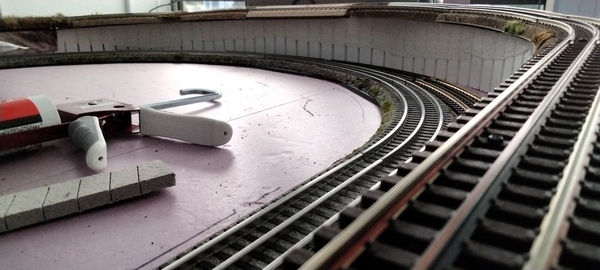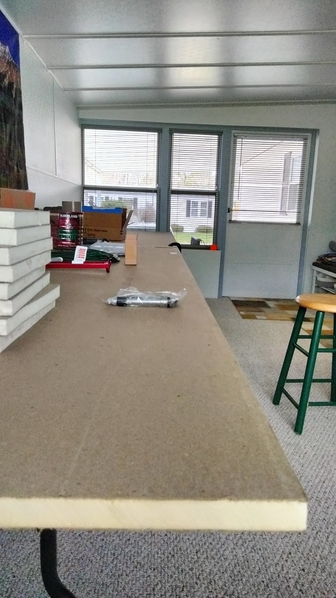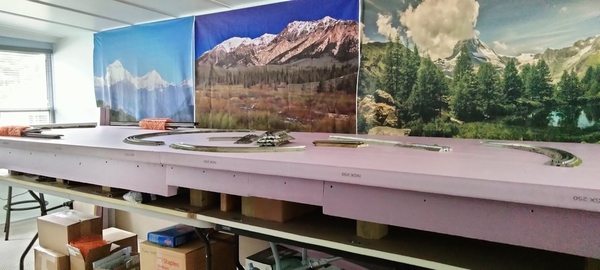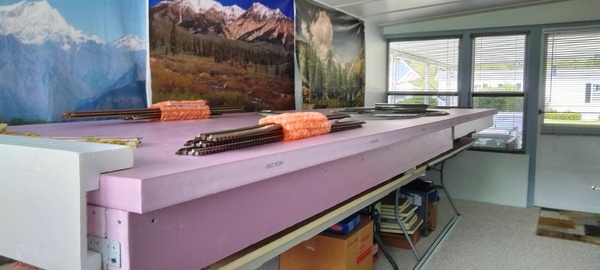I have seen many videos of 2 Rail O Scale Layouts and all of them take up a large amount of space. I currently have a 5ft'12' layout & I am wondering if a 2 Rail O Scale layout can be built within that space?
Replies sorted oldest to newest
I think you can have a nice layout in your 5'X12' space.
Many years ago, when Atlas was first introducing its 2-rail O-scale line, Model Railroader ran an article about an O-scale pike with 42" radius curves (I don't think it was O-42). I don't remember the issue or the exact size, but it was intended to showcase O-scale in a smaller than normal space. You might be able to search for it on an index Trains.com. There 's also another online index; I would have to look for the link if that doesn't work out for you.
A semi-circle of 42" radius won't fit in 5' though. For an oval, you are limited to 28" radius. I'm no expert in 2-rail, but that sounds like trolley, switcher, or old-time 4-4-0 type equipment.
@The-576-Guy posted:I have seen many videos of 2 Rail O Scale Layouts and all of them take up a large amount of space. I currently have a 5ft'12' layout & I am wondering if a 2 Rail O Scale layout can be built within that space?
Maybe watching videos is a wee bit misleading as to actual requirements as an absolute? Requirements are based upon your actual objectives.
All depends on what you are trying to model -- 5' is a bit deep to reach into - can you access that from both sides? 12' long makes for a lot of opportunity in a switching point to point operations arrangement.
BTW, my layout is in an 11' x 16' room and runs around the walls and loops around w/o blocking the entrance way -- small steam, small diesel, trolleys, and mostly cars 40' or less in length are completely possible.
I'm far from an expert but a 5' foot wide loop would require o-54 (27" radius) curves which, based on my o-54 3-rail layout experience, wouldn't work very well with fixed pilot locos. From what I've seen most 2-rail layouts are either point-to-point, around the wall, or very large tables with centre cutouts for access.
Having an idea of what equipment you’d like to run should help determine if you can make it work in that space.
Early Atlas O Scale used 2 rail track made by Pola I believe, as did AHM, and Rivarossi also did 2 rail O track that was a tighter radius than what is available from Atlas today (I think their smallest 2 rail radius now is O-36). The original Atlas F units and Fairbanks Morse engines would work on this tighter radius but I doubt more modern fixed pilot engines would. If you want a continuous loop you will be limited to short wheelbase locos or make an end to end/switching layout.
The Pola Maxi/AHM/Rivarossi O track comes up regularly on the Bay and they even made lengths of flex track as well. If you wanted to run steam you’d probably be limited to switch engines such as 0-4-0 or 0-6-0, or possibly smaller older style 4-4-0 locos.
O Scale 2 rail minimum curves normally are O36 or 72 inches. I have a small collection of Atlas O 2 Rail locomotives and cars plus a couple of 3rd Rail locomotives. I watch on Youtube O Scale Railroadfan which is a shelf layout plus Ryan Express Trains. I have used Karl's Trains on eBay plus Public Delivery Track for my purchases. There are a couple of 2 Rail online magazines. I am not sure of our forum rules but they are good resources available. Hopefully this will give you a few resources.
PS: I have kept for myself a series of articles in the MR Jan-March 2020 of a 2 rail O Scale layout I would like to build soon written by Tony Koester. Plus OGR past magazines have a ton of 2 Rail layouts via an online subscription.
An oval for continuous running on a 5-foot-wide table would have a maximum radius of less than 30-inches and limit you to very small 2-rail O scale locomotives. On a 12'-by-5' table, you could build a 2-rail O scale switching layout. If you require continuous operation, you could consider a 3-rail scale layout for the table size you have. I built a 10'-by-5' hi-rail layout with just an oval of Atlas O-54 track (see photo). The scenery and structures are as realistic as I could make them but I compromised by using 3-rail track.
MELGAR
Attachments
Amazing; from your prior posts, I thought that you had a large room-filling layout!
Atlas O originally produced O24 or 48 inch radius track for 2 rail. The issue using this track one is limited to O24 radius locomotives and prime examples areSW8/9, the original Atlas 1970 F and Plymouth locomotives. There are other manufacturers one must be sure they will work on O24. I do know Atlas O 2 rail 40 foot cars will negotiate O24 curves.
@PRRMP54 posted:Amazing; from your prior posts, I thought that you had a large room-filling layout!
Dave,
I have two layouts. The larger one is 12'-by-8' and pictured below. I posted the photo of my 10'-by-5' layout because it speaks to the question asked by @The-576-Guy as to whether it's possible to build a 2-rail O-scale layout in 5'-by-12'. In my opinion, if the space is 5'-by-12' a 2-rail O-scale switching layout could be built but the space is not large enough for continuous running (an oval). In that case, I would suggest a 3-rail scale layout with a loop of O-54 track.
MELGAR
Attachments
@SouthernFan56 posted:Atlas O originally produced O24 or 48 inch radius track for 2 rail. The issue using this track one is limited to O24 radius locomotives and prime examples areSW8/9, the original Atlas 1970 F and Plymouth locomotives. There are other manufacturers one must be sure they will work on O24. I do know Atlas O 2 rail 40 foot cars will negotiate O24 curves.
This is quite true. Those old Atlas F units and 40' boxcars will negotiate those curves. Some small steam will also handle those curves. I have a Lionel camelback from about 20 years ago that I had converted to 2 rail and there was so much slop in the drivers that the minimum radius never increased after being converted to 2 rail. The camelback will still handle the O36 curves (18 inch radius) that it was originally designed for so it would definitely handle the O48 (24" radius) of older Atlas track.
So yes you could have a 2 rail oval in a 5' by 12' area but you would be limited to small equipment that you could run on it.
@Hudson J1e posted:So yes you could have a 2 rail oval in a 5' by 12' area but you would be limited to small equipment that you could run on it.
That may be true but I don't think it's a good idea to invest the time, money and effort on a layout on which only a few types of small locomotives could be run. Locomotives wear out, break, or become unrepairable. Then, what do you run on the layout?
MELGAR
@MELGAR posted:Dave,
I have two layouts. The larger one is 12'-by-8' and pictured below. I posted the photo of my 10'-by-5' layout because it speaks to the question asked by @The-576-Guy as to whether it's possible to build a 2-rail O-scale layout in 5'-by-12'. In my opinion, if the space is 5'-by-12' a 2-rail O-scale switching layout could be built but the space is not large enough for continuous running (an oval). In that case, I would suggest a 3-rail scale layout with a loop of O-54 track.
MELGAR
Yes, I recognize those bridges, a great place for a photo-shoot.
@MELGAR posted:That may be true but I don't think it's a good idea to invest the time, money and effort on a layout on which only a few types of small locomotives could be run. Locomotives wear out, break, or become unrepairable. Then, what do you run on the layout?
Only a few types? Really? Let's see......0-4-0's, 0-6-0's, 2-4-0, 4-4-0's, 2-6-0's, 2-8-0's, and then small single 4 wheel truck diesels and then small 4 wheel 2 truck diesels including a RS-3....and then lot of 2 truck traction freight motors up to a B+B-B+B freight motor.....
And, I have yet to ever have any locomotive wear out or break, so no repairs.......none of which has anything to do with their being "small".
A 5' wide is 60", you can have 56" radius curve with space left over. Most 2 rail will run on 42" radius, if you have 40' box cars you can have 36"radius. With 12' length you can have a nice long run.
The absolute widest curves I'd recommend personally are 28" radius or O56
I think we are talking about 2 rail so 28" radius will not work.
28" radius is 56" diameter and the table is 60" across. If the OP wants an oval, then he is limited to 28" more or less
I must be missing something if 5 ft is 60 in, and you take 4 in off you have 56 in radius curve. This would be 112 in diameter. I took the 4in off so you have the track off the edge.
if you take 4 inches off, you'd have a 56 inch diameter curve, that works out to 28 inch radius
Well, 28" radius it is. If you do ON-30 you can go that tight, but for 2 rail you will need 36" minimum.
@MELGAR posted:Locomotives wear out, break, or become unrepairable. Then, what do you run on the layout?
MELGAR
What does the number of rails have to do with locomotives wearing out or becoming unrepairable? And if in the unlikely case that this did happen the user would simply get them repaired or if they needed to replace the locomotive they would get a new one from the same sources they got their original locomotives. I believe that any kind of mechanical problem whether it is a 2 rail or 3 rail locomotive can be repaired if the person is willing to spend the money to get it fixed. The value of the locomotive and the cost of the repair will be the determining factors. The one thing that isn't repairable is proprietary electronics. Once those go bad and are no longer stocked by the manufacturer the user (in the 3 rail world) then has to go to either a plain e-unit or if they want command control they go to ERR components or a DCS upgrade kit but they may never be able to get that original sound set back which may have been better than the aftermarket sound sets. In the 2 rail world electronics are usually made by a company that also sells them separately so in the event of a failure the user can get their original sound set back or possibly upgrade to an even better sound set.
Why not consider a small city or industrial area with a lot of street running and switches and the like.
Unless you have a huge basement with several "routes" you'll quickly tire of watching your train run in circles.s
Switching/kicking cars can provide hours of entertainment. And you could build some type of loop into the layout for the time you simply want to hear the click clack of the rails.
A small yard for sorting your train and a lot of sidings and buildings could keep you entertained.
@Rule292 posted:...snip... Unless you have a huge basement with several "routes" you'll quickly tire of watching your train run in circles. ...snip...
Never! I find that the sound of metal wheels on metal track very soothing. I suspect that (having never owned any) those all-plastic(?) New Bright trainsets would do in a pinch, too.
@Rule292 posted:Why not consider a small city or industrial area with a lot of street running and switches and the like.
Unless you have a huge basement with several "routes" you'll quickly tire of watching your train run in circles.s
Switching/kicking cars can provide hours of entertainment. And you could build some type of loop into the layout for the time you simply want to hear the click clack of the rails.
A small yard for sorting your train and a lot of sidings and buildings could keep you entertained.
This is what I would do. You could use code 100 rail and #4 switches and maybe use a selector plate. You just have to decide what you like.
This post has me curious so I just bought some old Pola Maxi track to see what it looks like in a 5’X12’ footprint. I’ll also see if All Nation 4-6-0 and 4-4-2 locos can handle the radius. I’ll report back here with photos once the track arrives
This situation comes along more than it should. The AWE of O scale 2 rail 100% prototype Locos, and cars are extremely enticing'.. There's so many variations of track radius, subconference, and the math involved'... Many of us have our own ideas what will work and what won't.
Briefly, If I may, after relocating to new retirement digs, no basement, no garage. But a "Sun Room", 12' X 20'. Leaving behind a 5' X 13" O Gauge 3Rail, to currently under construction a 4' X 16', O Gauge 3Rail.
Initially I wanted a 42" wide to give me more walking space in the room. My curves are 42" however, I discovered, an additional six (6) inches is required. So, a 42 radius is actually a 48 radius. Re-construction necessary. I would imagine each additional radius would require the same extra space.
What we need is a simple method of figuring radius and space required without being a mathematician...
I too love proto O scale. BUT' to have a really good looking and operating layout does require adequate correct space'..
I was complaining quite a bit about being short on space. My wife said just make adjustments and be happy with what you have'.. So I have'..
Hers a few pics..
Attachments
@Rule292 posted:Why not consider a small city or industrial area with a lot of street running and switches and the like.
Unless you have a huge basement with several "routes" you'll quickly tire of watching your train run in circles.s
Switching/kicking cars can provide hours of entertainment. And you could build some type of loop into the layout for the time you simply want to hear the click clack of the rails.
A small yard for sorting your train and a lot of sidings and buildings could keep you entertained.
Have always wondered about kicking cars or having a hump track (if I got that right). What's your procedure for kicking?
@Quarter Gauger 48 posted:Briefly, If I may, after relocating to new retirement digs, no basement, no garage. But a "Sun Room", 12' X 20'. Leaving behind a 5' X 13" O Gauge 3Rail, to currently under construction a 4' X 16', O Gauge 3Rail.
Initially I wanted a 42" wide to give me more walking space in the room. My curves are 42" however, I discovered, an additional six (6) inches is required. So, a 42 radius is actually a 48 radius. Re-construction necessary. I would imagine each additional radius would require the same extra space.
What we need is a simple method of figuring radius and space required without being a mathematician...
Just trying to end further confusion. To my knowledge in all model railroad scales/gauges track curvature is measured in Radius except 3 rail O which is measured in diameter. Radius is measured from the center of the circle to the outside of the circle. Diameter is measured as a straight line going from one side of the circle through the center point of the circle to the other side of the circle. Thus diameter is always twice as large as radius.
@Quarter Gauger 48 I think I know what you mean in your post. I once had a 3 rail layout on a 4x8 and I used MTH O42 Realtrax. The track curves were 42" in diameter but I needed the extra few inches on each side so the track wasn't sticking off the end of the board therefore I needed 48" of space to have the O42 curves fit but the radius does not change. It is still O42 track which has a diameter of 42" and a radius of 21". Another thing to remember is not all 3 rail track systems are measured the same way. I believe some are measured from the center of the circle to the center rail and some are measured from the center of the circle to the outside rail. I don't recall which is which.
I like your layout room. Lots of sunlight! And your layout is off to a good start! Good luck!
HudsonJ1e is correct about diameter measurement variations for 3-rail O gauge track. But, I also think he erred about radius determination of SCALE gauges (O, S, HO, N, etc.). I believe scale radii are measured from the center of the circle to the mid-point between the curved rails, not to the outer edge of the ties ("the edge of the circle?"). This is why a 26" radius (52" diameter) in any scale size requires 56" of table space (and then some for safety of equipment).
Chuck
Thanks Phil'. Appreciate your response'.... {BTW} that sun room has been completely rebuilt.. from a tin shack to a complete luxurious accommodation'... Yes sir, the light is excellent for layout photography'... 👍📸
@PRR1950 posted:HudsonJ1e is correct about diameter measurement variations for 3-rail O gauge track. But, I also think he erred about radius determination of SCALE gauges (O, S, HO, N, etc.). I believe scale radii are measured from the center of the circle to the mid-point between the curved rails, not to the outer edge of the ties ("the edge of the circle?"). This is why a 26" radius (52" diameter) in any scale size requires 56" of table space (and then some for safety of equipment).
Chuck
Chuck, you are correct. I should have made myself more clear. I was trying to say that only in 3 rail O are there different track systems that measure the radius/diameter in different ways. In all the other scales it is done as you said. Thanks for pointing that out as I was trying to end confusion and not create more confusion.













